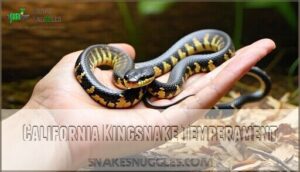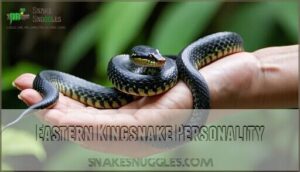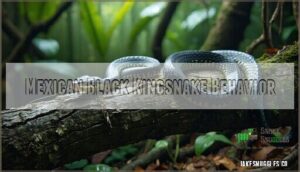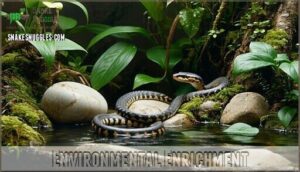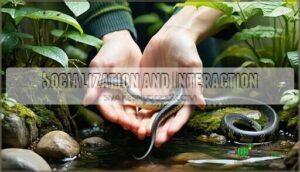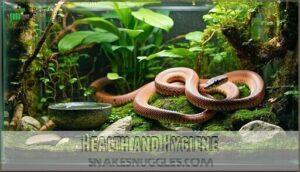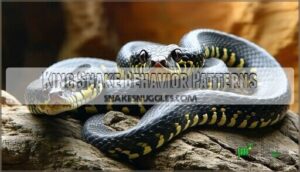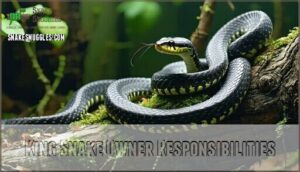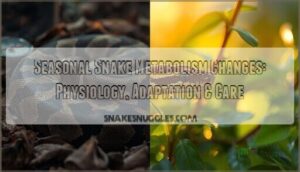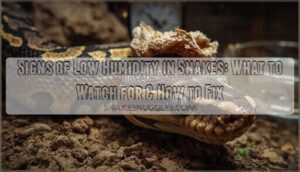This site is supported by our readers. We may earn a commission, at no cost to you, if you purchase through links.
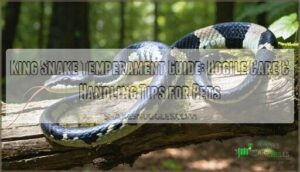 King snakes make excellent pets thanks to their naturally calm disposition.
King snakes make excellent pets thanks to their naturally calm disposition.
You’ll find these reptiles are generally docile and rarely bite once they’ve settled into their environment.
While young king snakes might be defensive initially, they typically calm down with consistent, gentle handling.
They’re constrictors, but don’t worry—they won’t hurt you during normal interaction.
Most species adapt well to captivity and become quite tolerant of human contact.
Their predictable temperament makes them ideal for both beginners and experienced keepers.
However, each subspecies has unique behavioral traits that can substantially impact your experience as an owner.
King snakes are also known for being excellent pets due to their overall nature.
Table Of Contents
- Key Takeaways
- King Snake Temperament
- Choosing Right King Snake
- King Snake Care Tips
- King Snake Behavior Patterns
- King Snake Owner Responsibilities
- Frequently Asked Questions (FAQs)
- What is the temperament of a king snake?
- Do kingsnakes like to be held?
- What is the most docile king snake?
- Are king snakes friendly pets?
- Can king snakes live with other snake species?
- How often do king snakes shed their skin?
- What temperature range do king snakes need daily?
- Do king snakes require special lighting or UVB?
- How long do king snakes typically live?
- Conclusion
Key Takeaways
- You’ll find king snakes naturally docile and beginner-friendly – they rarely bite, adapt well to captivity, and become increasingly calm with consistent gentle handling over time.
- Start with brief 5-minute handling sessions twice weekly – this builds trust gradually while avoiding stress, and you should skip handling during feeding periods or shedding cycles.
- California king snakes offer the most predictable temperament – they’re typically calmer than Eastern or Mexican black varieties, making them ideal if you’re new to snake ownership.
- You’re committing to 15-20 years of specialized care – this includes maintaining proper temperature gradients, providing secure hiding spots, and budgeting $200-500 annually for their needs.
King Snake Temperament
You’ll discover that kingsnakes are among the most beginner-friendly reptile pets, known for their calm demeanor and predictable behavior patterns.
Their docile temperament makes them excellent starter snakes, though understanding their natural instincts helps you provide better care and build trust through proper handling techniques, utilizing their predictable behavior.
Docile Nature
King snake temperament makes these docile snake species perfect beginner snakes for first-time owners.
Their calm demeanor and nonaggressive snake behavior create ideal pet suitability, rarely biting unless threatened.
This calm snake breed’s gentle handling requirements showcase clear docile benefits for novice keepers.
They’re also known as opportunistic feeders in their natural habitat.
Here are five key temperament traits you’ll observe:
- Minimal aggression – They prefer hiding over confrontation when startled
- Stress tolerance – Adapts well to captive conditions and human presence
- Predictable responses – Defensive behaviors like hissing serve as clear warnings
- Manageable size – Their 2-6 foot length stays comfortable for handling
- Consistent personality – Most individuals maintain calm dispositions throughout their 20+ year lifespan
Handling and Taming
Short handling sessions help your snake adjust to human contact and reduce defensive behaviors like musking.
Start with five-minute sessions twice weekly, using slow movements to build trust. Avoid handling within 48 hours after feeding or during shedding.
Providing opportunities for behavioral and physical enrichment can further reduce stress and improve their overall well-being. Consistent taming techniques create calmer, more manageable pets over time.
Aggression and Defense
Most king snakes avoid confrontation, preferring escape over aggression.
When cornered, they’ll display defensive behaviors like hissing, musking, and tail vibration. These stress indicators warn you to back off.
While biting potential exists, non-venomous strikes are rare warnings, not attacks. Understanding stress signals is essential for safe interaction.
Snake temperament varies individually, but mitigation strategies include gradual handling and recognizing snake defensive behaviors to reduce handling risks effectively.
Choosing Right King Snake
You’ll want to take into account each kingsnake species’ unique personality traits before making your choice.
California kingsnakes offer calm, docile temperaments perfect for beginners, while Eastern kings display more active behaviors and Mexican blacks tend to be slightly more defensive initially but settle into gentle companions with proper handling, showcasing their ability to become gentle companions.
California Kingsnake Temperament
California kingsnakes offer excellent docility factors for new snake owners.
They are adaptable reptiles that show moderate bite risk when young but develop impressive handling ease through consistent interaction.
Their high activity levels make them entertaining pets, though individual variation means some remain more defensive.
Regular gentle handling transforms even nippy juveniles into calm, tolerant adults perfect for captivity.
They thrive with humidity between 35-60% in their enclosure.
Eastern Kingsnake Personality
Eastern kingsnakes are famously calm but pack surprising personality.
They are glossy black beauties with white chain-like bands that adapt well to handling, though juveniles may bite initially.
Their docile nature and moderate activity levels make them excellent pets.
They have several distinctive features, including:
- Sleek black bodies gleaming like polished obsidian
- Distinctive white or yellow chain patterns wrapping around muscular frames
- Confident movements as they explore every corner of their enclosure
- Gentle constriction around your arm during handling sessions
- Impressive appetites tackling prey with methodical precision
These characteristics, combined with their ability to thrive in captivity, make them a popular choice for reptile enthusiasts, offering an exciting opportunity to observe and interact with these fascinating creatures.
Mexican Black Kingsnake Behavior
Mexican black kingsnakes display generally docile temperaments but show defensive mechanisms like musking and quick strikes when startled.
Their solitary nature makes enclosure interaction minimal, though juvenile behavior tends more defensive initially.
These crepuscular snakes exhibit nocturnal activity patterns and strong constricting abilities.
You’ll find their snake temperament becomes predictable with consistent handling, making king snake behavior manageable for experienced keepers seeking calmer reptile companions, which can be a result of their constricting abilities.
King Snake Care Tips
Proper king snake care goes beyond basic feeding and housing to create an environment where your scaly companion truly thrives.
You’ll need to focus on three key areas: enriching their habitat, building trust through regular interaction, and maintaining excellent health standards.
Environmental Enrichment
Proper snake enrichment transforms basic housing into thriving habitats.
Your king snake needs at least four inches of burrowing depth using aspen or coconut fiber substrate.
You can find suitable bedding options online.
Add climbing opportunities with sturdy branches and logs.
Create enclosure complexity through multiple hiding spots, leaf litter, and naturalistic design elements.
Rearrange snake enrichment items monthly to provide sensory stimulation and encourage natural snake behavior patterns.
Socialization and Interaction
Your snake’s trust-building journey starts with brief five-minute handling sessions, gradually increasing as comfort develops.
Regular human interaction twice weekly builds tolerance and reduces defensive responses, while consistent handling frequency promotes positive snake pet temperament.
Recognizing stress signals like rapid movements prevents setbacks, and King snake interaction requires patience—social limitations mean they prefer predictable routines over frequent disturbance.
Positive snake pet temperament is the ultimate goal, achieved through patience, understanding, and a well-planned interaction schedule.
Health and Hygiene
Daily spot-cleaning prevents disease while complete substrate replacement every three months controls bacterial buildup.
You’ll need fresh water weekly and should watch for respiratory infections, parasite prevention issues, and shedding problems.
Regular vet checkups catch snake health concerns early.
Shedding occurs frequently for younger snakes.
Quarantine protocols protect your collection from snake common health issues requiring reptile health expertise and snake veterinary care to prevent bacterial buildup and ensure the snakes’ overall well-being.
King Snake Behavior Patterns
Understanding your king snake’s natural behavior patterns helps you create better care routines and recognize normal versus concerning activities.
These instinctive behaviors include their methodical hunting techniques, secretive hiding preferences, and seasonal breeding cycles that affect their overall temperament and needs, which can be influenced by understanding their natural behavior.
Hunting and Feeding Behavior
Understanding your king snake’s predatory instincts helps you provide proper care and feeding schedules. These carnivorous reptiles are powerful constrictors that naturally hunt diverse prey in the wild.
Your snake’s feeding requirements include:
- Prey Constriction – Strongest constrictors relative to body size among snakes
- Feeding Frequency – Hatchlings every 5-7 days, adults every 10-14 days
- Frozen vs. Live – Prekilled rodents are safer than live prey
- Dietary Variety – Naturally eat rodents, birds, lizards, frogs, other snakes
- Supplementation Needs – Monthly calcium dusting supports bone health
Shelter and Hiding Behavior
Your kingsnake’s hiding frequency depends on enclosure security and stress levels.
These natural burrowers need secure hides on both warm and cool sides for proper temperature control.
Substrate burrowing behavior increases when they feel threatened or during environmental changes.
Multiple hiding spots throughout the enclosure reduce stress and allow natural thermoregulation.
Poor temperature gradient or inadequate shelter triggers excessive hiding behavior patterns, which can be mitigated by providing secure hides and a proper environment, allowing for natural burrowing behavior.
Mating and Breeding Behavior
Beyond hiding spots, your kingsnake’s reproductive instincts emerge during breeding season from March through August.
Males compete fiercely using neck-biting and vibrating courtship rituals to win females.
Understanding snake reproduction helps you recognize these natural behaviors in your pet.
Here’s what happens during kingsnake breeding:
- Courtship Rituals – Males track females using chemical cues and engage in competitive combat with other males
- Clutch Size – Females lay 2-20 eggs (averaging 9) in rotted logs or sawdust piles after mating
- Incubation Period – Eggs develop for 40-70 days depending on temperature and humidity conditions
- Hatchling Care – Baby snakes emerge 8-13 inches long and stay near the nest for one week
Snake breeding pairs require specific breeding conditions including proper temperatures and genetic diversity considerations.
Most pet owners won’t breed their kingsnakes, but recognizing these snake courtship behaviors helps you understand your pet’s natural instincts.
King Snake Owner Responsibilities
Owning a king snake means you’re signing up for a 15-20 year commitment that requires consistent attention to their specialized needs.
You’ll need to master enclosure management, recognize health warning signs, and provide the stable environment these escape artists demand throughout their long lives.
Providing Suitable Enclosure
You’ll need adequate enclosure size to support your king snake’s temperament—adults require minimum 40-gallon tanks.
Substrate choice matters for burrowing comfort; use aspen or coconut fiber 2-3 inches deep. Install hiding spots on both warm and cool sides for security.
Maintain proper temperature gradient from 75-85°F. Many owners purchase complete king snake setups for convenience.
Prioritize cage security with latched tops since these escape artists will test every weakness in your snake enclosure setup.
Managing Stress and Health
How can you spot trouble before it becomes a crisis? Watch for snake stress signals like refusing food, excessive hiding, or restless pacing.
Quarantine protocols prevent disease spread, while regular vet checkups catch respiratory infections and shedding problems early.
It’s also important to reflect on internal parasite control. Parasite prevention and monitoring your snake’s temperament guide guarantees superior snake health through proactive care.
Long-Term Commitment and Care
Owning a kingsnake means you’re signing up for a 15-20 year journey that’ll outlast many life changes.
These reptiles become part of your family story, requiring consistent care through moves, career shifts, and major milestones.
Lifespan Expectations and snake longevity considerations:
- Financial Burden – Budget $200-500 annually for food, substrate, utilities, and veterinary care throughout their snake lifespan
- Space Requirements – Maintain adequate housing even when relocating, as adult kingsnakes need permanent 40+ gallon setups
- Owner Lifestyle – Plan vacations around feeding schedules and guarantee reliable pet-sitters understand snake longterm care protocols
- Future Planning – Consider who’ll inherit your snake if circumstances change, since snake ownership spans decades of commitment
To guarantee their well-being, remember to provide appropriate temperature gradients.
Frequently Asked Questions (FAQs)
What is the temperament of a king snake?
Contrary to fears about aggressive snakes, king snakes are remarkably docile and calm.
You’ll find they’re gentle, rarely bite, and adapt well to handling, making them excellent beginner pets with predictable, steady temperaments, which showcases their remarkably calm nature.
Do kingsnakes like to be held?
Most kingsnakes tolerate handling well once they’re comfortable with you, but they don’t actively seek or enjoy it like some pets do. They’re typically calm and manageable during brief sessions.
What is the most docile king snake?
California Kingsnakes are typically the most docile kingsnake species.
You’ll find they’re naturally calm, rarely bite, and adapt well to handling.
Their even temperament makes them perfect beginner pets compared to other subspecies, with a naturally calm demeanor.
Are king snakes friendly pets?
Before smartphones ruled the world, you’d have called these serpents "gentle giants."
King snakes make surprisingly friendly pets with their docile temperament and ease of handling.
They’re naturally curious, rarely bite, and adapt well to human interaction when properly cared for.
Can king snakes live with other snake species?
No, you shouldn’t house king snakes with other species. They’re cannibalistic and will eat other snakes, including venomous ones. Keep them solitary to prevent stress and predation.
How often do king snakes shed their skin?
While some reptiles shed monthly like clockwork, your kingsnake follows its own schedule, typically shedding every 4-8 weeks. Young snakes shed more frequently than adults as they grow rapidly.
What temperature range do king snakes need daily?
Your king snake thrives in a thermal gradient: maintain 75-80°F on the cool side and 85-88°F on the warm basking spot during daylight hours.
Do king snakes require special lighting or UVB?
Unlike your grandfather’s dim terrarium bulbs, king snakes don’t need special lighting or UVB bulbs.
They’re nocturnal hunters who thrive in ambient room lighting.
You’ll save money since regular day-night cycles work perfectly for their health and behavior.
How long do king snakes typically live?
With proper care, you’ll see your king snake thrive for 15-20 years in captivity, though some exceptional specimens have reached their mid-twenties with excellent husbandry practices.
Conclusion
Mastering your king snake temperament guide will transform your reptile ownership experience completely.
You’ll discover that these remarkable serpents offer years of rewarding companionship when you understand their unique behavioral patterns.
Their naturally calm demeanor, combined with proper handling techniques and appropriate environmental conditions, creates an ideal pet snake scenario.
Remember that patience during the initial adjustment period pays dividends in long-term temperament stability.
Your commitment to consistent care routines guarantees a docile, handleable companion for decades, showcasing the importance of long-term temperament stability.
- https://reptilesbymack.com/king-snake-care-sheet/
- https://rattlesnakesolutions.com/snakeblog/keep-snakes-away/releasing-kingsnakes-to-control-rattlesnakes-is-not-a-good-idea/
- https://zoomed.com/kingsnake/
- https://commons.wikimedia.org/wiki/File:Lampropeltis_getula_getula.jpg
- https://creativecommons.org/licenses/by-sa/2.5

